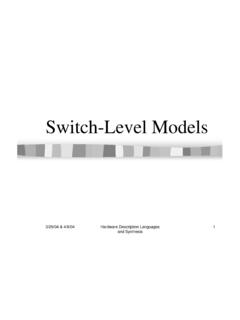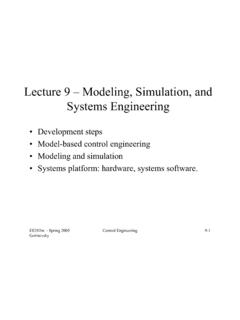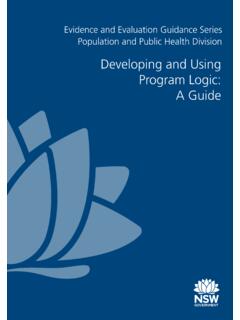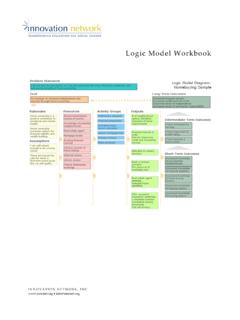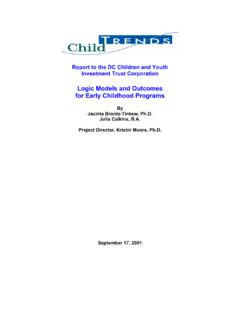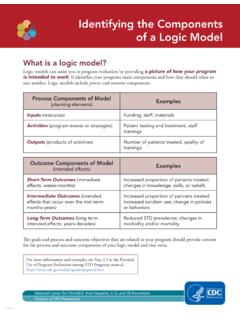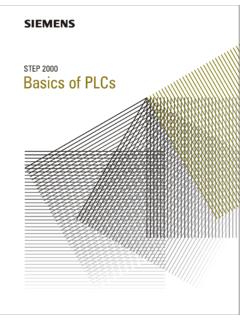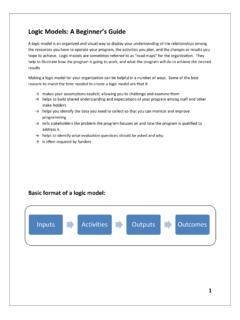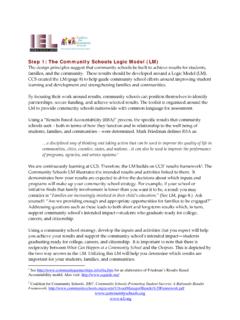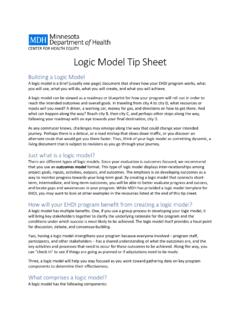Transcription of Using a Logic Model to Effectively Identify and Measure ...
1 Using a Logic Model to Effectively Identify and Measure Outcomes to Ensure an Effective System Of Care Courtney Gaskins, , Vice President of Programs Youth For Tomorrow The proposed workshop will provide participants with examples and take away materials in building and sustaining programs through the use of a Logic Model . The presenter will take participants through the process of creating a Logic Model ; provide examples of Logic models for services typically contracted through CSA; and finally show participants how to expand the Logic models use in identifying outcomes and collecting and analyzing data that allow for clear results and/or continuous improvement of services. This workshop specifically addresses the conference theme of Building an Effective System of Care and touches on Data Informed Policy and Practice and Integrating Evidence-based Practices. Training Description: Essential definitions related to service/program outcomes and evaluation. A basic introduction to what a Logic Model is and how it can be used as an action-oriented tool for service/program planning and evaluation.
2 Exercises and examples that focus on the development of a simple service/program Logic Model to a more complex organizational Logic Model , including practical examples and a template for developing a Logic Model . Expanding on how a basic Logic Model can be used in effective program evaluation; collecting, analyzing, and providing data/results to share with stakeholders; and in learning to continually improve programs. Learning Objectives: - something that happens as a result of an activity or process Synonyms: result, end result, consequence, net result, upshot, aftereffect, aftermath, conclusion, issue, end, end product Outcomes the making of a judgment about the amount, number, or value of something; assessment Synonyms: assessment, appraisal, judgment, gauging, rating, estimation, consideration Evaluation Performance management should be incorporated into all aspects of services, from initial intake to discharge Staff gather evaluative data both formatively, during the course of service, as well as, summatively, or at the conclusion of each month, quarter and year-end Should include both process evaluation and product evaluation Outcomes as it relates to Performance Process Evaluation involves developing ongoing evaluations, especially during the implementation of major strategies through various programs to accept, refine, or correct the program design ( evaluation of intake, recruitment, orientation, transition, and retention of staff).
3 The purpose is to provide decision makers with information necessary to determine if the program needs to be accepted, amended, or terminated. The task typically involves: (1) identifying discrepancies between actual implementation and intended design (2) identifying defects in the design or implementation plan The methods may involved a staff member serves as the evaluator, and who monitors and keeps data on setting conditions, program elements as they actually occurred. This person provide feedback on discrepancies and defects to the decision makers. Collected both formatively and summatively. Process Evaluation Product Evaluation involves the evaluation of the outcome of the program to decide to accept, amend, or discontinue the program, Using criteria directly related to the goals and objectives ( put desired student outcomes into question form and survey pre- and post-). The purpose is to decide to accept, amend, or terminate the program The task includes developing the assessment(s) of the program.
4 The methods should include traditional research methods, multiple measures of objectives, and other methods. Collected both formatively and summatively. Product Evaluation Process Evaluation will include gathering information about how successful the service (program/project) is in meeting required planned services and to assess its impact on the targeted population For example: 1) Site visits or administrative observations; 2) exit interviews; and, 3) professional development training completed Process and/or Product For example: Pre- and post- tests that show improvements over time: Grades Life Skills Level of Anxiety 2) Goals over time Positive changes in behavior Number of Restraints over time 1)Benchmarks The product performance measures focus on: and, 2) improvement in staff knowledge and qualifications. The following product data will be collected: Product Evaluation Examples (2) Collection of Information (3) Organization of Information (4) Analysis of Information (5) Reporting the Information (6) Administration of the Evaluation (1) Focus the Evaluation Structuring the Evaluation Assessment Planning Develop Goals and Objectives Design a Program Design and Implement Pilot the Program Evaluate the Pilot Adopt, Amend, Drop It Institutionalize the Program Evaluate the Institutionalized Program Relationships Among Planning, Evaluation and Decision Making Most evaluation designs include both process and product evaluation to: (1) better determine the effectiveness of the services/ program on the targeted population; (2) document that services/ program objectives were or are being achieved; (3) provide information about service delivery that will be beneficial to program staff.
5 And, (4) enable staff to make changes that improve service/program effectiveness. Evaluation Design Work Flow During this workshop participants will learn how to develop and use a Logic Model to evaluate programs or services. A Logic Model is a tool used by funders, managers, and evaluators of programs to evaluate the effectiveness of a program. Logic models can be useful methods for identifying outcomes that show effective results. A Logic Model is a graphical depiction of the logical relationships between the resources, activities, outputs and outcomes of a program. Participants will learn how to create a Logic Model and expands its use towards effective program evaluation; collecting/analyzing data to provide results to stakeholders; and continually improve programs over time. Purpose and Objectives Logic Model Measures: Outputs & Outcomes Results Youth Village # Performance Management Tools PERFORMANCE MANAGEMENT Performance management includes activities to ensure that goals are consistently being met in an effective and efficient manner.
6 Performance management tools include Logic models, performance measurement and program evaluation. Logic Model Tool / framework that helps Identify the program / project resources, activities, outputs customers, and outcomes. Performance Measurement Helps you understand what level of performance is achieved by the program/project. Program Evaluation Helps you understand and explain why you re seeing the program/project results. Planning tool Communication tool Implementation tool Measurement design Evaluation design What are Logic Models Used For? Illustrates the Logic or theory of the program or project. Focuses attention on the most important connections between actions and results. Builds a common understanding among staff and with stakeholders. Helps staff manage for results and informs program design. Finds gaps in the Logic of a program and work to resolve them. What are the Benefits of Logic Models? 1. Clarify the program goal and define the elements of the program in a table.
7 2. Verify the Logic table with stakeholders. 3. Develop a diagram and text describing logical relationships. 4. Verify the Logic Model with stakeholders. Then use the Logic Model to Identify and confirm performance measures and in planning and evaluation. How Do You Develop a Logic Model ? A picture of your program. Graphic and text that illustrates the relationship between your program s activities and its intended outcomes and results. What is a Logic Model ? Output: Products and services provided as a direct result of program/proposal activities. Outcome: Changes or benefits resulting from activities and outputs. Accomplishment of program goals and objectives. short-term (Change in knowledge, skills, understanding, attitude) intermediate outcomes (Change in behavior) long-term outcomes impacts (Change in the environment) Outputs and Outcomes Mapping out Your Work Plan What is the problem or need you are addressing? What are your planned activities to address this need?
8 What resources will you need to do these activities? What are your anticipated accomplishments/outputs of your activities? Logic Models and Work Plan Development Who do you expect to act as a result? What do you expect them to do? What benefits ( , environmental, human health) do you expect to result from these actions? Identifying and Developing Performance Measures Performance Management Tools PERFORMANCE MANAGEMENT Performance management includes activities to ensure that goals are consistently being met in an effective and efficient manner. Performance management tools include Logic models, performance measurement and program evaluation. Logic Model Tool / framework that helps Identify the program / project resources, activities, outputs customers, and outcomes. Performance Measurement Helps you understand what level of performance is achieved by the program/project. Program Evaluation Helps you understand and explain why you re seeing the program/project results.
9 Performance Measurement: The ongoing monitoring and reporting of program progress and accomplishments, Using pre-selected performance measures. Performance Measure : A metric used to gauge program or project performance. Indicators: Measures, usually quantitative, that provide information on program performance and evidence of a change in the state or condition in the system. Definitions: What are they? Questions designed to assess progress/ accomplishments of various aspects of a program/project. Performance measurement questions ask/tell you what your program is doing. Performance Measurement Questions Performance Questions Across the Performance Spectrum Measures Across the Logic Model Spectrum Work Load/Quality Measures Step 1: Identify Potential Measures Step 2: Assess Each Measure Step 3: Choose the Best Measures Step 4: Identify Baseline, Target, Timeline and Reporting Schedule Steps for Developing Measures STEP 1: Identify the information needed and the audience Identify measures in existing documents Review the Logic Model and select the appropriate Logic Model element Express the Logic Model element as a performance Measure Determine if the Measure clearly relates to the program/project goal or objective Key Steps in Identifying Potential Measures Review the performance measurement questions developed earlier Consider what information is needed to assess whether your program/project is meeting its goals and objectives.
10 Ask yourself: Who needs to know what about the program, why, and in what format? STEP 1: Identify the information needed and the audience Review measures specified in: Program/Project Mission, Goals, Objectives, Service standards Legislation, Strategic plans Previous evaluations and research reports Consider other sources Identify Measures in Existing Documents Review the Logic Model Identify the aspects of performance that are most important to Measure (resources, activities, outputs, outcomes) Identify contextual factors that could influence the program either positively or negatively and generate measures for them as appropriate Review the Logic Model Consider how to express the Measure in terms of: Data: Raw Numbers Averages Percentages Ratios Rates Unit of Measure : Is it appropriate to the Measure ? Express the Logic Model element as a performance Measure Review the program/project mission and or goal What key activities, outputs or outcomes are specified in the mission or goal?

